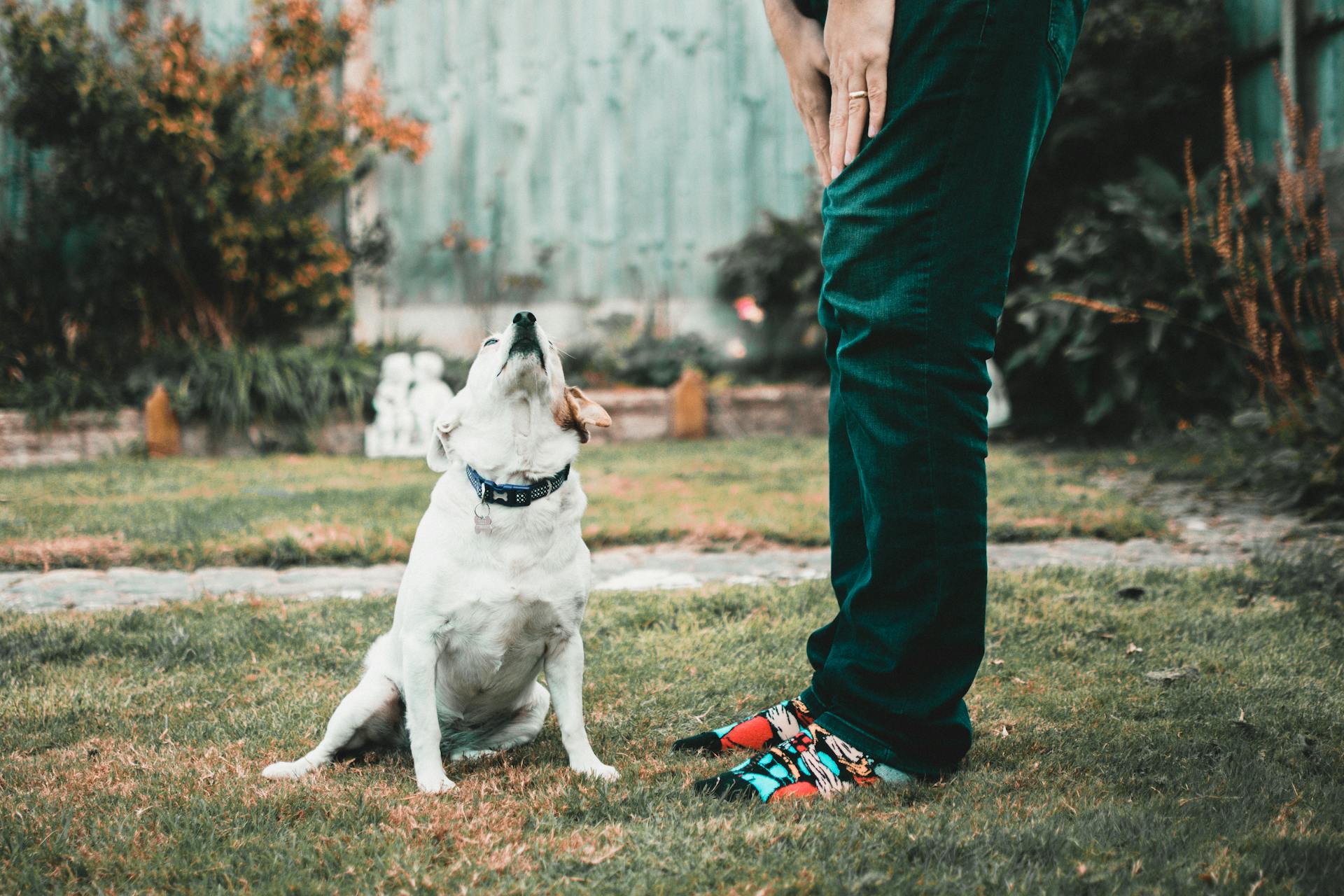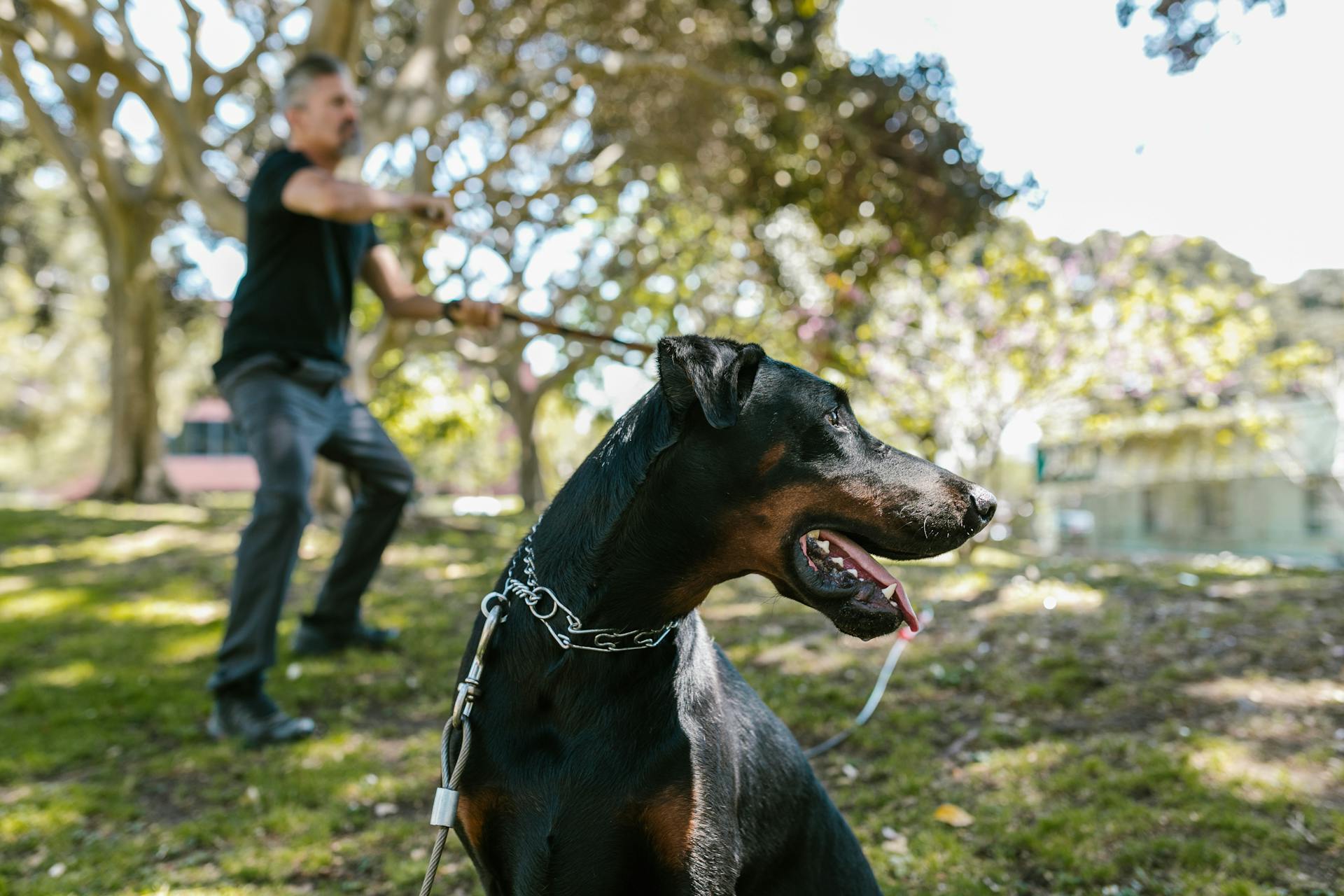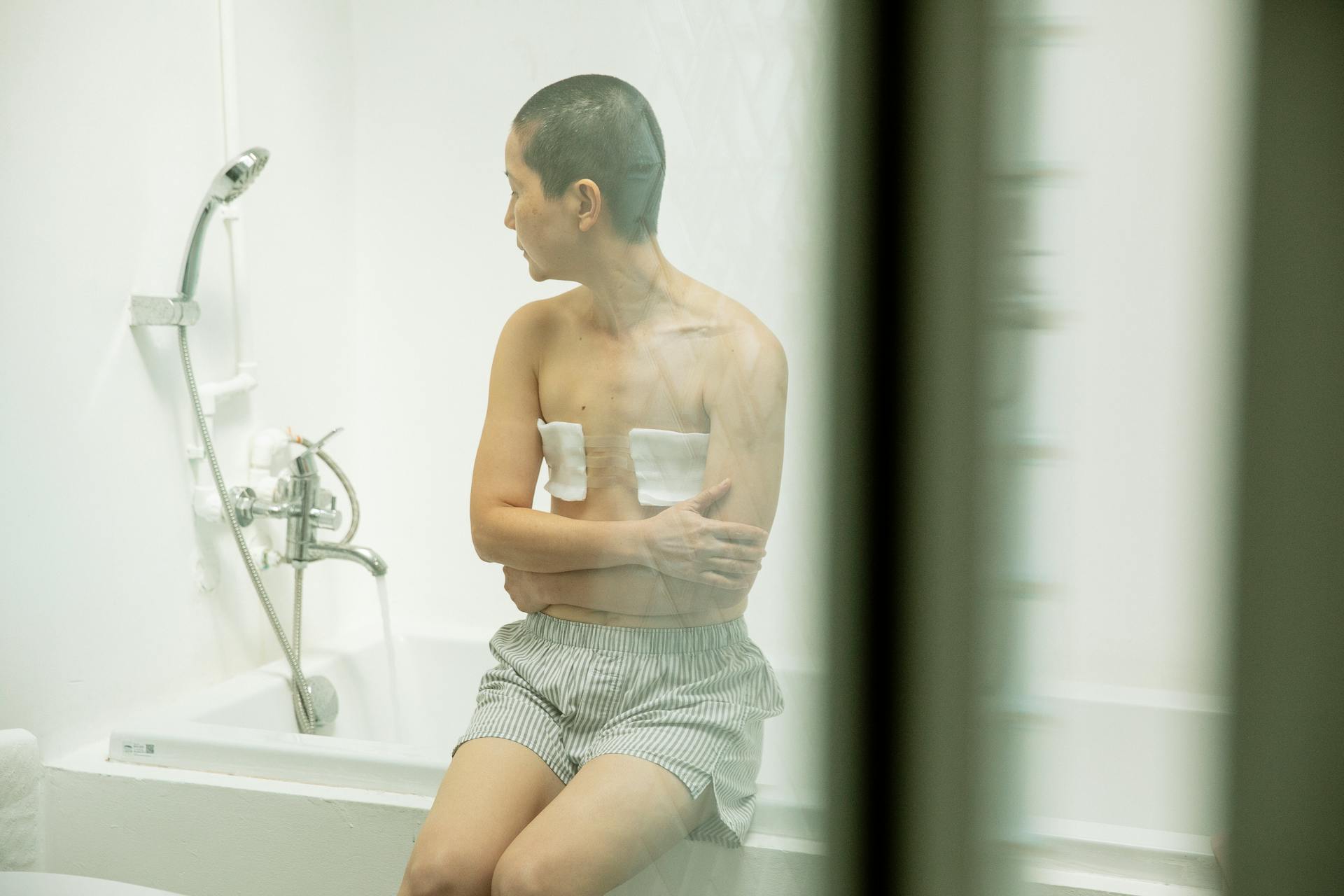
Gastric dilatation volvulus surgery can be a life-saving procedure for dogs affected by this condition. The surgery typically involves a gastropexy, a surgical procedure that attaches the stomach to the abdominal wall.
During the surgery, your veterinarian will make a large incision in the dog's abdomen to access the stomach. The stomach is then carefully untwisted and secured to the abdominal wall to prevent future GDV episodes.
The surgery can be performed under general anesthesia, and the dog will need to be hospitalized for several days to recover.
Your veterinarian will provide you with post-operative care instructions to ensure your dog's smooth recovery.
Signalment and Presentation
If you have a large or giant-breed dog, you're more likely to be at risk for Gastric Dilatation Volvulus (GDV). This is especially true for breeds like German Shepherds, Great Danes, and Saint Bernards.
Deep-chested breeds are more prone to GDV, which means their chest is longer than it is wide. This unique body shape can put pressure on the stomach, increasing the risk of bloat.
As your dog ages, the risk of GDV increases. Most patients are middle-aged to older, and it's essential to keep an eye out for signs of bloat, especially in older dogs.
Some breeds, like Shar-Peis, Basset Hounds, and Cocker Spaniels, may also be at risk due to their deep chest conformation.
Here are some common risk factors for GDV:
- Large- or giant-breed dog
- Deep chest conformation (increased thoracic depth-to-width ratio)
- Increasing age
- Familial history, particularly having a first-degree relative with a history of GDV
- Previous episode of gastric dilatation
- Preexisting gastrointestinal disease or gastric foreign body
- History of previous splenectomy
- Large volume of food fed once daily
- Eating a meal quickly
- Dry dog food
- Eating from a raised food bowl
- Anxiety or stress
Causes and Pathophysiology
Dogs with a deep chested large breed conformation, such as Great Danes and German Shepherds, are more susceptible to Gastric Dilatation and Volvulus Syndrome.
Older dogs are also at a higher risk, although they don't have a higher mortality rate with treatment and can still be considered for surgery.
Some breeds, like Weimaraners and Setters, are more prone to GDV due to their deep chested large breed conformation.
Dogs that are stressed and anxious, thin and underweight, or fed only one large meal each day are also at a higher risk.
Feeding large amounts of food and water quickly, exercising immediately after eating, and eating dry food diets can also contribute to GDV.
Here are some breeds that are more susceptible to GDV:
- Great Danes
- German Shepherds
- Saint Bernards
- Setters
- Weimaraners
Causes
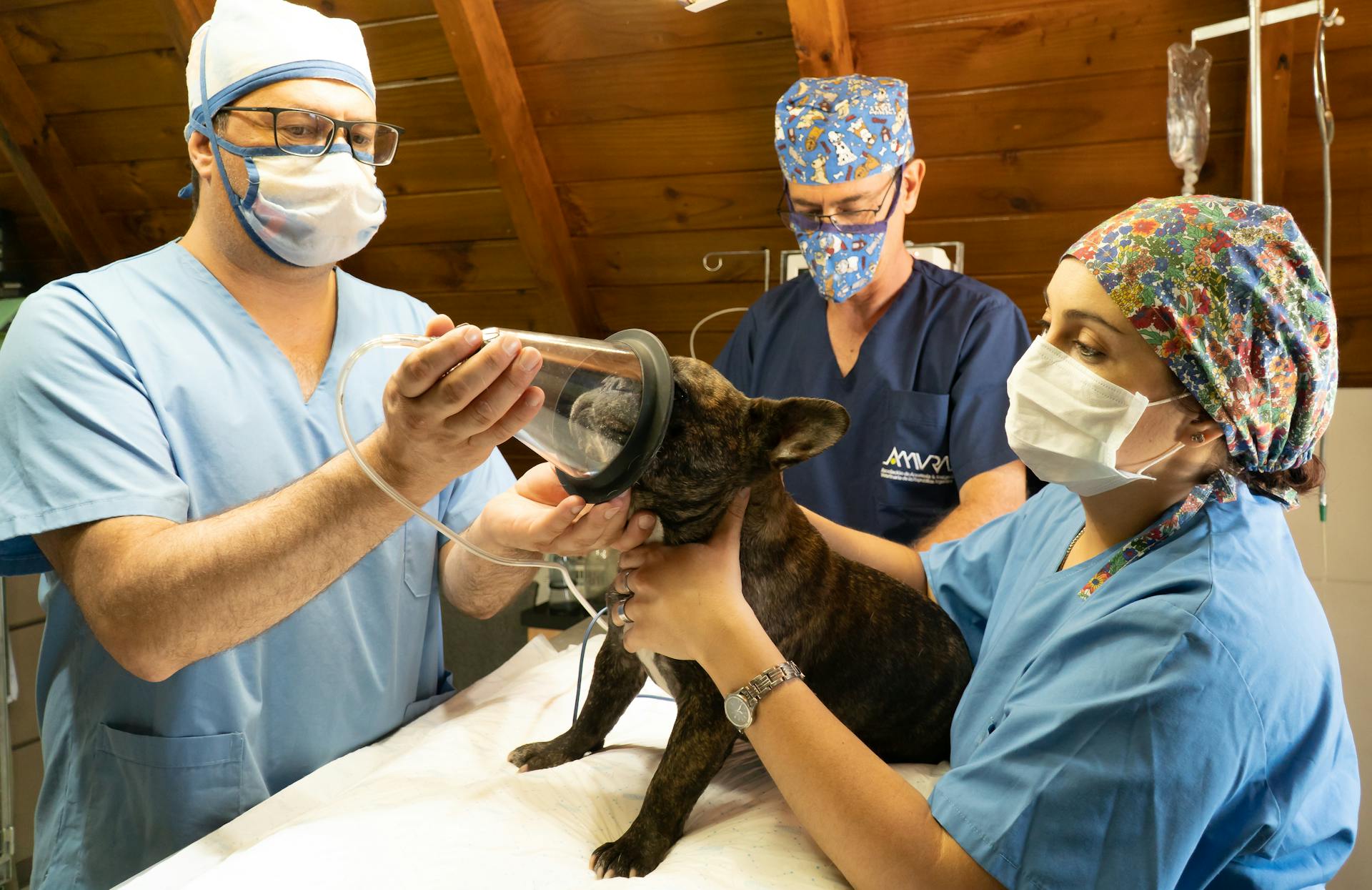
Dogs with deep chests, such as Great Danes and German Shepherds, are more prone to Gastric Dilatation and Volvulus (GDV) syndrome.
Some breeds that are at higher risk include Great Danes, German Shepherds, Saint Bernards, Setters, and Weimaraners.
As dogs get older, their risk of GDV increases.
Stress and anxiety can also contribute to the development of GDV.
Dogs that are thin and underweight are more susceptible to the condition.
Feeding only one large meal per day can increase the risk of GDV.
Eating quickly and consuming large amounts of food and water can also contribute to the condition.
Dogs on dry food diets are more likely to develop GDV.
Exercising immediately after eating can also increase the risk of GDV.
Some dogs may be more prone to GDV due to hereditary factors.
Here are some breeds that are at higher risk of GDV due to their deep chests:
- Great Danes
- German Shepherds
- Saint Bernards
- Setters
- Weimaraners
Pathophysiology
The underlying cause of GDV remains unknown, but it's believed to be multifactorial and can vary among patients, breeds, and scenarios.
Dogs with a family history of GDV are at higher risk, as are large and giant purebred dogs with a higher thoracic depth:width ratio.
Nervous, fearful, and aggressive dogs are more prone to GDV than calm dogs.
Risk also increases with age, but older dogs don't have a higher mortality rate with treatment and should still be considered for surgery.
Large meal volume, once-daily feeding, rapid eating habits, and diets with oils or fats in the first 4 listed ingredients are additional risk factors in breeds already at increased risk.
Some studies suggest that previous splenectomy patients may be 5.3 times more likely to develop GDV.
The authors of this study recommend performing gastropexy at the time of splenectomy in dogs with additional risk factors for GDV.
Predisposing Factors
Large and giant breeds of dogs are more susceptible to Gastric Dilatation and Volvulus (GDV) syndrome, including Great Danes, German Shepherds, Saint Bernards, Setters, and Weimaraners.
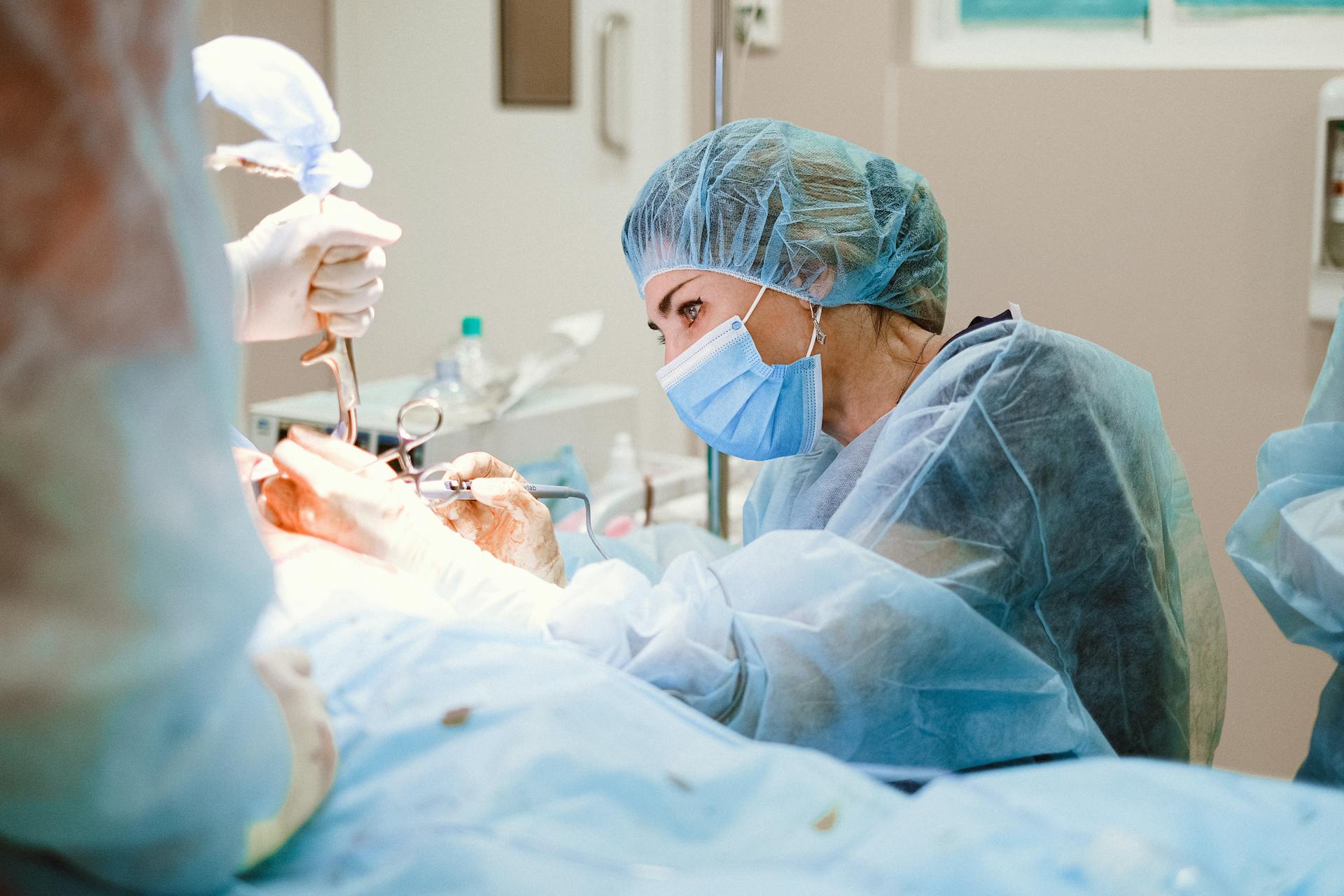
Dogs with a family history of GDV are at higher risk, and breeds with a higher thoracic depth:width ratio are also more prone to the condition.
Older dogs are at greater risk of developing GDV, with the risk increasing by 33% with each year of age.
Dogs with a higher thoracic depth-to-width ratio are at greater risk of GDV, which may be due to the different anatomical relationship between the stomach and the esophagus in these animals.
Anxious temperament has been perceived as a predisposing factor for GDV, and owners of dogs who have developed GDV often report their dogs as being nervous or fearful.
Feeding one large meal a day, feeding from a height, and certain dietary ingredients have been linked to an increased risk of GDV, although cause-and-effect relationships have not been fully elucidated.
Here are some breeds that are at higher risk of developing GDV:
Dogs that have had a splenectomy are also at increased risk of developing GDV, and the removal of the spleen may increase space within the abdomen, allowing the stomach to have more mobility and increasing the risk of GDV.
Diagnostic Tests
Initial diagnosis of Gastric Dilatation and Volvulus Syndrome is based on patient history, signalment, and presenting clinical signs. A thorough physical examination, including abdominal palpation, will be performed to feel for distension and tympany.
Radiographs are a crucial diagnostic tool, and a right lateral projection is often diagnostic. A healthy dog typically has no gas in the pylorus in right lateral recumbency, but in a dog with GDV, the stomach is dilated with gas, and radiography depicts the hallmark sign of compartmentalization.
Blood parameters that are evaluated include a complete blood count, serum chemistry, and electrolytes. These tests are performed to determine the severity of any metabolic disturbances occurring due to the condition.
The initial blood values and electrocardiogram are especially valuable as pre-operative baselines. They help assess patient stability and monitor the effectiveness of volume resuscitation.
Point-of-care assessment, including packed cell volume/total solids, blood glucose, and venous blood gas, is often more practical in emergency situations. Lactate, a marker of hypoperfusion and anaerobic metabolism, has been evaluated as a prognostic tool in patients with GDV.
Higher lactate values are more suggestive of gastric necrosis and have a negative correlation with survival. Regardless of the lactate value, surgical intervention is always recommended.
Thoracic radiographs can also be obtained in the preoperative period, particularly in older patients, to check for thoracic metastasis or other comorbidities.
For more insights, see: Blood Sugar Levels for Dogs with Diabetes
Treatment and Surgery
Treatment of Gastric Dilatation and Volvulus Syndrome in Dogs is a serious matter that requires immediate veterinary attention. The longer it is left untreated, the more internal damage there will be.
To stabilize the patient, strong fast-acting analgesics are administered to manage the extreme pain, and intravenous fluid therapy is used to restore circulating volume and correct shock. This usually involves placing two large-bore IV catheters and administering a bolus of fluids.
Decompression of the stomach must be done to address the dilatation. This is usually done by orogastric intubation, where a large diameter tube is passed into the stomach to release the gas, and then lavaged with warm water. If this is not possible, trocarization is performed.
Surgical correction is required to straighten out the twisting of the stomach. The most common technique is Gastropexy, which involves suturing the stomach to the abdominal wall to prevent reoccurrence of twisting.
Worth a look: Dog Gastric Dilatation Volvulus
Here are the steps involved in the surgery:
- Reposition the abnormally positioned stomach
- Critically evaluate the abdominal viscera
- Perform a right-sided gastropexy to create a permanent adhesion between the pyloric antrum and the adjacent right body wall
The gastropexy tacks the stomach into its normal position, so that it can never twist again. A preventive gastropexy is an elective surgery that can be performed at the time of spay or neuter in a breed considered at risk for GDV.
A ventral midline approach to the abdomen is made from the xiphoid to the caudal third of the abdomen. The surgeon repositions the stomach by pushing the fundus dorsally and to the left, while simultaneously pulling the pylorus ventrally and toward the right.
Gastric necrosis appears as black or white tissue, is thin on palpation, does not have peristalsis, and should be resected. The necrotic area of the stomach should be oversewn with an inverting pattern to isolate necrotic tissue to the gastric lumen.
Gastropexy creates a permanent adhesion between the antrum and body wall and dramatically reduces GDV recurrence. Several gastropexy techniques have been described, and are similarly effective at preventing recurrence.
Here are the different techniques for performing right-sided gastropexy:
- Incisional gastropexy
- Belt-loop gastropexy
- Circumcostal gastropexy
- Ventral incision/incorporating gastropexy
- Stapled gastropexy
- Tube gastropexy
- Laparoscopic-assisted gastropexy
Recovery and Care
Following surgery, your dog will be monitored for several days for sepsis, cardiac difficulty, and other complications.
Dogs will be sent home with medications including pain relief, antibiotics, protectants for the gastric lining, and gastric motility modifiers.
Food must be reintroduced slowly with a highly digestible bland diet fed in several small meals throughout the day.
Exercise will be restricted in the period immediately following surgery and until the incision is fully healed.
Long-term management focuses on preventing a reoccurrence by feeding two to three small meals per day instead of one large meal.
The survival rate for dogs that receive prompt treatment is high, with some estimates suggesting a survival rate of up to 93%.
ECG monitoring should be continued in the post-operative period as cardiac arrhythmias are common following GDV.
If cardiac arrhythmias are significant, treatment with lidocaine may be necessary.
Fluid therapy should be continued until the patient is eating and drinking.
Additional reading: Pyometra in Dogs Home Remedies
Pain relief will be dependent on the individual patient, with opioids such as methadone given in the initial post-operative phase, and transition to buprenorphine when possible.
Nausea post-operatively can be treated with medication such as maropitant.
Gastric atony and delayed gastric emptying can occur after gastric dilatation, so antiemetics or prokinetics may be administered if vomiting or regurgitation is observed postoperatively.
Continuous ECG monitoring should be closely monitored because more than half to three-quarters of patients experience postoperative arrhythmias within the first 12 to 24 hours after surgery.
On a similar theme: What Causes Twisted Stomach in Dogs
Cost and Prognosis
The cost of gastric dilatation volvulus (GDV) surgery can be steep, ranging from $300 to $3,600, depending on various factors such as anesthesia, hospital time, and surgical complexity. This cost includes initial stabilization, gastric decompression, and surgical correction.
The prognosis for dogs undergoing GDV surgery is not always favorable, with a mortality rate ranging from 10% to 33% in the postoperative period. This rate increases in dogs with certain poor prognostic indicators, such as lactate level not responding to fluid resuscitation or gastric necrosis.
Some factors associated with increased mortality include clinical signs lasting more than 6 hours, presence of gastric necrosis, need for splenectomy, and preoperative arrhythmias. It's worth noting that prophylactic gastropexy, a surgical procedure, can reduce the risk of GDV recurrence to less than 5% in susceptible breeds.
Readers also liked: Twisted Stomach in Dogs Survival Rate
Cost of

The cost of treating Gastric Dilatation and Volvulus Syndrome in dogs can be steep. Initial stabilization will cost between $300 - $550.
Gastric decompression is another essential treatment that can start at $200 and go up to $450. This allows the stomach to be decompressed, either with orogastric intubation or trocarization.
Surgical correction is the most expensive part of the treatment, costing between $1,000 and $3,600. This depends on various factors, including anesthesia, the state of the animal, hospital stay, IV requirements, and the amount of dead tissue that needs to be removed.
Supplements can be used to help with instant pressure, but they're not a substitute for veterinary attention and will cost between $30 - $85. They should be provided en-route to the hospital.
Suggestion: Canine Lick Granuloma Treatment
Prognosis
The prognosis for dogs with GDV can be quite serious. If your dog is treated surgically, the mortality rate is between 10% to 28%.
Poor prognostic indicators include a lactate level that doesn't respond to fluid resuscitation. This is a sign that the dog's body is not recovering as quickly as it should. The need for a splenectomy is also a bad sign, as it indicates that the dog's spleen is damaged beyond repair. Gastric necrosis, or the death of tissue in the stomach, is another indicator of a poor prognosis.

If your dog is experiencing preoperative arrhythmias, or irregular heartbeats, it's a sign that the condition is more severe than initially thought. The longer your dog's clinical signs last, the worse the prognosis will be. If your dog is severely ill at the time of presentation, it's a bad sign. Hypotension, or low blood pressure, during hospitalization is also a concern. Peritonitis, or inflammation of the lining of the abdominal cavity, and sepsis, or a life-threatening response to an infection, are both serious complications that can arise from GDV.
Here are some of the poor prognostic indicators for GDV:
- Lactate level not responding to fluid resuscitation
- Need for splenectomy
- Gastric necrosis and need for partial gastrectomy
- Preoperative arrhythmias
- Increased time between clinical signs and admission
- Severity of physical condition at the time of presentation
- Hypotension at any time during hospitalization
- Peritonitis or sepsis
- Disseminated intravascular coagulation
Prevention
Prevention is key when it comes to gastric dilatation volvulus (GDV). Surgery is the best course of action to prevent recurrence, which can be as high as 55% to 75% without gastropexy.
If your dog is at risk for GDV, prophylactic gastropexy is recommended to reduce the risk of recurrence. This surgery decreases recurrence to less than 5%.
Performing gastropexy during routine abdominal procedures in susceptible breeds, such as Great Danes, German shepherd dogs, and standard poodles, can help prevent GDV.
Postoperative mortality rates are high, ranging from 10% to 33%, so it's essential to take preventative measures to reduce the risk of complications.
Sources
- https://wagwalking.com/condition/gastric-dilatation-gdv
- https://todaysveterinarypractice.com/gastroenterology/gastric-dilatation-volvulus-stabilization-surgery/
- https://www.fentonrivervet.com/gastric-dilatation-and-volvulus-gdv/
- https://vetfocus.royalcanin.com/en/scientific/gastric-dilatation-and-volvulus
- https://www.cliniciansbrief.com/article/gastric-dilatation-volvulus-dogs
Featured Images: pexels.com
